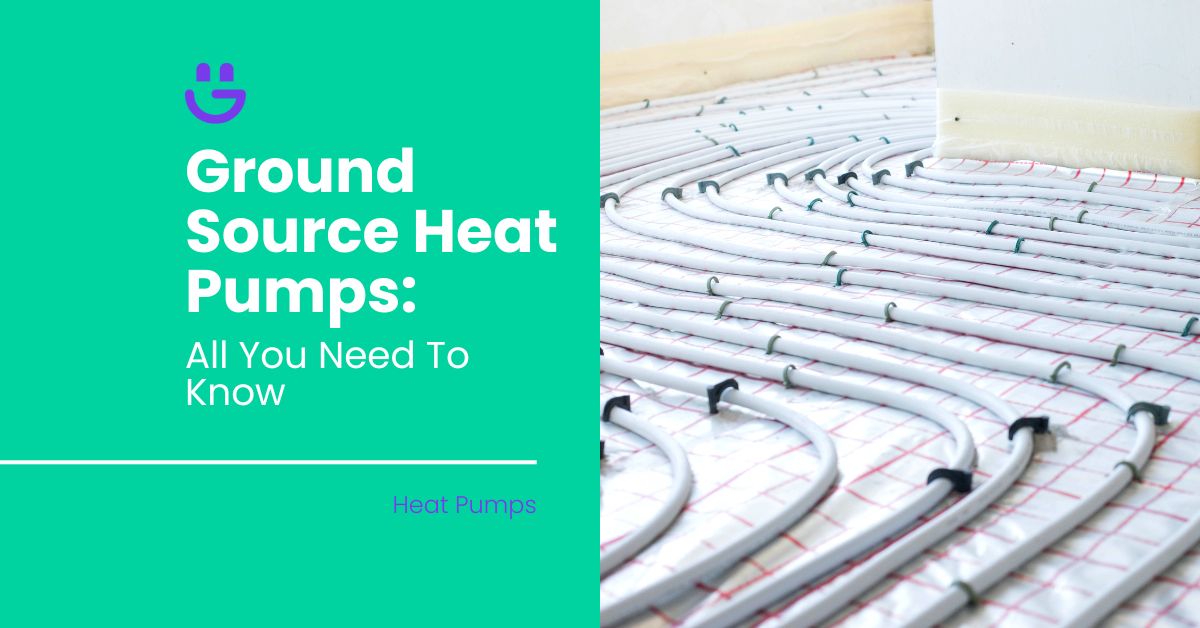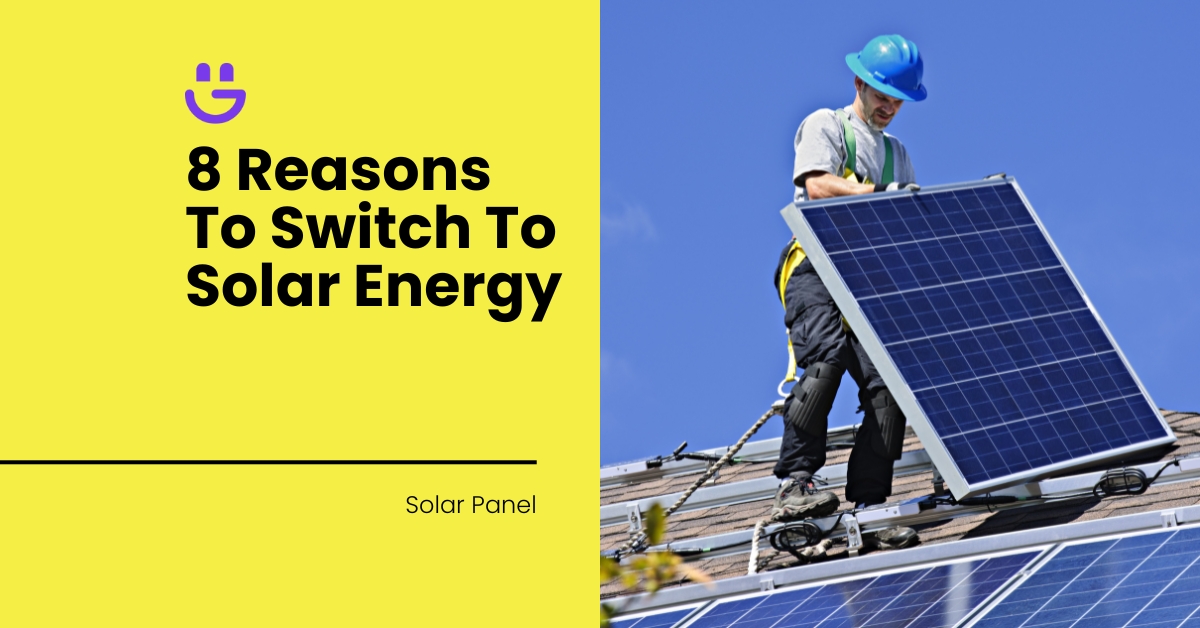Last Updated on November 14, 2025
Ground source heat pumps are changing the way we view home heating in the UK. As the country gradually moves away from gas boilers, air source and ground source heat pumps have become the exciting home heating solutions of the future.
Currently, a government financial incentive of £7,500 is available to homeowners who invest in a ground source heat pump. We expect more money to be offered to homeowners in the years ahead to encourage the take up of ground source heating.
Against this backdrop, let’s look at ground source heat pumps in more detail. How do these pumps work? What do they cost? How are they installed? How efficient is a ground source heat pump? What finance is available? This guide answers all of these questions – and more – as we examine the nuts and bolts of ground source heat pumps.
Contents
- 1 Understanding Ground Source Heat Pumps
- 2 Types Of Ground Source Heat Pumps
- 3 Ground Source Heat Pump Costs
- 4 Ground Source Heat Pump Installation
- 5 How Efficient Are Ground Source Heat Pumps?
- 6 Ground Source vs Air Source Heat Pump: A Comparison
- 7 Funding For Ground Source Heat Pumps
- 8 Pros And Cons Of A Ground Source Heat Pump System
- 9 FAQs
- 9.1 Can a ground source heat pump be used for both heating and cooling?
- 9.2 Do ground source heat pumps require planning permission?
- 9.3 Can ground source heat pumps be used as part of a hybrid heating system?
- 9.4 Do ground source heat pumps need a lot of maintenance?
- 9.5 Are ground source heat pumps noisy?
- 9.6 What factors should be considered before installing a ground source heat pump?
- 10 Conclusion
Understanding Ground Source Heat Pumps
What is a ground source heat pump?
A heat pump is a heating system that transfers thermal energy from one place to another. It uses refrigerant-based technology to convert thermal energy to heat to warm your property and provide hot water.
A ground source heat pump, as the name suggests, uses the relatively stable temperature of the ground to provide this useful heating. It extracts heat from the ground through a series of buried pipes and transfers it into a building via a heat exchanger.
A ground source heat pump has two main elements:
- Ground loops: The ground loop system (ground array) is a network of pipes buried underground. This pipe network can be installed in horizontal trenches or vertical boreholes depending on the ground space and geological conditions. Less frequently, the ground array is sunk into a water source such as a pond to extract thermal energy from the water and generate heat.
- Heat pump unit: The heat pump unit is installed inside the building, usually close to an external wall. It contains the compressor, heat exchanger, and controls. Depending on the power output and sophistication of the unit, it may be as large as a tall filing cabinet or almost small enough to fit in a cupboard. Large units often include an integrated hot water cylinder.
The heat pump extracts the heat energy from the refrigerant circulating within the system and transfers it to the building’s heating system.
How does a ground source heat pump work?
There are six main steps in the ground source heat pump functioning process:
- Ground source heat pumps use water and antifreeze, which it pumps into the buried pipe network.
- This fluid mix, or loop fluid, circulates through the pipes, absorbing heat from the surrounding soil and rock.
- The heated fluid is then pumped into the heat pump unit where it transfers its heat to the system’s special refrigerant.
- The refrigerant vaporises the heat into gas.
- The gas is compressed and becomes even hotter.
- The hot refrigerant gas passes through a heat exchanger and the heat is released into the building’s heating system to warm underfloor heating, radiators, and water for your taps.
Benefits of ground source heat pumps
The benefits of ground source heat pumps are manifold. The main ones are lower carbon emissions, reduced energy bills (up to 50% by some estimates), eligibility for government incentives, and long-term sustainability.
The beauty of ground source heating is that it taps into the earth’s natural heat reservoir and efficiently delivers the heating you require (provided your home is well insulated). To do this, it uses a relatively small amount of electricity to power components like fan systems, controls, and a compressor.
A heat pump is much more efficient than a gas or oil boiler and, when paired with renewable energy, it is an environmental winner. This explains why ground and air source pumps have emerged as leading solutions to heat the green homes of tomorrow.
Types Of Ground Source Heat Pumps
Let’s look at the three primary types of ground heating systems. A key differentiator is the pipework involved.
Horizontal ground loop
In a horizontal ground loop, the pipe network is laid underground in horizontal channels. The network is usually laid around 1.2 metres to 1.6 metres below ground level. The pipes are either straight or coiled. Coiled pipes (also known as slinkies) allow you to extend a longer network without losing efficiency.
Pipes are commonly made of high-density polyethylene (HDPE) – a robust material resistant to decomposition and oxidation.
The length and layout of the trenches depend on factors such as the size of the property and the heat load requirements. This setup works best in unshaded areas with good access to sunlight.
Vertical ground loop
If your ground space is limited (say, smaller than a tennis court) or the shallow soil environment is unsuitable for horizontal piping, a vertical system may be necessary. A vertical ground loop system consists of a network of pipes that are installed vertically in boreholes.
Borehole depths can range from around 70 metres to 120 metres. Sometimes, a deeper borehole is recommended to take advantage of the fact that the earth’s temperature rises the deeper you go. Two or more boreholes may be necessary to tap into sufficient heat to meet requirements. Once the borehole is sunk, lengths of piping referred to as U-bends are inserted into the earth.
If a borehole is required, the cost of your ground source heat pump installation increases significantly. Total heat pump costs can escalate to £30,000 and more.
Water source pump system
Although this is rare, heat pumps sometimes take advantage of nearby bodies of water. This system uses the heat energy from the water in lakes, ponds, or streams to provide heating and hot water for your property.
This setup is known as a water source heat pump. In the UK, water source pumps fall into the broad category of ground source heat pumps, as they have similar characteristics, benefits, and efficiencies.
With a water source heat pump, pipes are installed via pond mats submerged in the body of water.
Ground Source Heat Pump Costs
As with all heating devices, the three main cost elements are:
- Unit purchase price
- Installation cost
- Operation or running cost
Purchase price
The purchase price of ground heating units ranges from around £4,000 to over £16,000.
You will find a wide range of ground source heat pumps on the market from leading brands like Viessmann, Worcester Bosch, Vaillant, Nibe, and more. Sizes (power outputs) range from 4 kW to over 40 kW, ensuring there is a pump to heat every structure – from apartments to large houses and homes with multiple occupancies.
The best models boast superior-quality materials and components that push up the price. Your property size and layout, your heating needs, and the pump brand, model, and size are some of the variables that determine the purchase price.
Installation cost
The installation cost is a major component of the ground source heat pump’s price tag. Installation costs can run from as low as £3,000 to over £30,000!
The main variable that impacts cost here is whether the installation requires horizontal or vertical groundwork. The pump’s kilowatt (kW) size, your property layout, your location, and complicating issues like overly wet ground or lots of rock are other factors that can affect the cost.
A straightforward installation of a 6 kW unit with a horizontal loop may cost only £4,000, while installing a 16 kW unit that requires two 100-metre-deep boreholes could amount to £30,000.
You also may need to factor in the costs of upgrading your home’s insulation and radiator network or fitting underfloor heating to accommodate the heat pump.
Depending on the circumstances, the overall cost of buying and having a ground source heat pump installed can vary from under £10,000 to over £40,000. Heat pump grants such as the Boiler Upgrade Scheme provide some help by offering consumers £7,500 (and sometimes more) toward the purchase.
Running costs
Heat pump running costs vary depending on your property and preferred temperature zones, your electricity tariff, the efficiency of your heat pump’s settings, and your local ground heat.
Typical UK homes might use between 3,500 kWh and 4,500 kWh a year to power their heat pumps. Based on a unit electricity rate of 29p per kWh, annual running costs equate to between £1,015 and £1,305.
What potential savings does a ground pump offer compared to conventional heating? Based on January 2024 fuel prices, the Energy Saving Trust estimates that annual savings from a heat pump are £105 when replacing a modern condensing gas boiler and £630 when replacing an old G-rated gas boiler. This is for an average well-insulated four-bedroom detached house.
Ground Source Heat Pump Installation
Here are seven key pointers to note about ground source heat pump installations.
- Firstly, not all properties are suitable for a ground pump. A poorly insulated home that doesn’t have enough land to provide the required heat load is not a good candidate for ground-source heating.
- Before any ground is broken, a professional heat pump installer will evaluate the available land and the extent of unshaded ground. This will help decide between horizontal pipework or vertical boreholes. The average home will need between 400 sq m to 1,000 sq m of clear space for a horizontal scheme.
- The installer will also focus on the soil conditions and composition, including how much clay there is (which holds more heat than sand).
- A survey report may be required to fully understand the geology of the ground and its potential.
- Once the type of system is agreed upon, the groundwork can commence. The job involves a fair deal of evacuation, piping, labour hours, equipment on site, and possibly borehole drilling. Things will be pretty invasive and disruptive in the garden for a few days. A complex project may last over a week.
- The heat pump unit doesn’t take as long to install but must be professionally fitted, connected, and tested by a qualified heat pump installer. It’s a good idea to house the heat pump in a separate room for working access, particularly if it’s a large unit with an integrated hot water tank.
- If your radiators are old, they will likely need to be replaced for low-flow (lower temperature) versions or underfloor heating. This is to optimise the efficiency of the heat pump which is designed to produce heat at a lower temperature than a conventional gas boiler.
How Efficient Are Ground Source Heat Pumps?
Ground source heat pumps are about the most efficient heating system available. The efficiency measure COP (Coefficient of Performance) is relevant here. It shows how much heat energy per unit of electricity a heating device can produce.
Ground source heat pumps operate with a COPranging from 3 to 5. This means that the best units generate an impressive 5 kW of heat energy for every1 kW of electricity used. These heat pumps enjoy an ErP (Energy-related Products) energy efficiency of A+++.
Here’s how other systems perform in comparison:
- Air source heat pumps: COP of 2 to 4.
- Gas boilers: Modern condensing boilers have a COP of 0.9 to 1. Some older boilers are closer to 0.6.
- Electric resistance heaters: COP of 1.
- Biomass boilers: Their efficiency varies but modern biomass boilers generally achieve a COP of around 0.8 to 1.2.
Are ground source heat pumps efficient in cold weather?
A ground heat pump’s piping is submerged more than a metre into the earth. At this depth, the earth holds its temperature fairly well. It doesn’t suffer a dramatic drop in warmth even if there is sleet above ground. Given this relatively stable heat, your ground source heat pump still operates well in cold weather.
The impact of cold weather is felt even less if your system is vertically installed. The conductivity of the earth also plays a part here. When heat is extracted from the ground adjacent to the pipework, it is naturally replaced by heat moving in from the surrounding space. The better the soil’s conductivity, the more efficiently this replenishment takes place.
It’s important to note that peak efficiency is only achieved when the heat pump is properly installed and regularly maintained.
Ground Source vs Air Source Heat Pump: A Comparison
Is a ground source heat pump better than an air source heat pump?
Air source heat pumps work by drawing thermal energy from the air and converting it to heat. An air source system typically uses less electricity to produce heat than a ground pump.
A ground heat pump performs more efficiently. Top-end ground heat pumps boast a COP of 5. An average air source unit has a COP of around 3. In addition, the efficiency of air source pumps tends to drop during the colder winter months when the ambient air temperature might fall well below zero.
Ground heat pumps are less affected by seasonal variations because the earth’s heat stays comparatively consistent and stable. This goes to the ground pump’s main advantage. It is better able to keep you consistently warm because it is less vulnerable to performance lapses in icy weather.
It also operates with only one pump unit whereas many air source arrangements need an indoor and outdoor unit (which potentially takes up more space and makes more noise).
On the other hand, an air source unit (including installation) is half the price of a ground unit. The difference could be as much as £15,000.
Ultimately, the choice between a ground or air source system depends on your personal circumstances and preferences. Your land area and layout, heating needs, local climate, earth composition, use of renewables, and budget will all likely factor into the equation.
Funding For Ground Source Heat Pumps
The UK Government acknowledges that heat pumps are an expensive investment. Various grants and schemes are intended to subsidise a share of the expense to encourage takeup and ease the transition to greener home energy.
Boiler Upgrade Scheme (BUS)
The Boiler Upgrade Scheme (BUS) is part of the government’s Heat and Buildings Strategy. The BUS provides a grant of £7,500 for homeowners and landlords to replace their old and inefficient oil or gas boiler with a new and efficient heat pump. Ground source heat pumps (which include water source heat pumps) and air source heat pumps qualify for this scheme. Hybrid heat pumps aren’t eligible.
ECO4 scheme
The Energy Company Obligation (ECO) 4 scheme obliges larger energy suppliers to provide funding for energy efficiency and low-carbon heating measures for low-income and vulnerable households. ECO4 is the fourth phase of the scheme which is currently set to run until 2026. Grants for ground source heat pump installations are included in the ECO4 package.
Home Energy Scotland Scheme
Funded by the Scottish Government, the Home Energy Scotland Grant and Loan scheme focuses specifically on helping homeowners access heat pumps. The scheme promotes low-carbon heat pumps to lower the carbon footprint of the country’s housing stock.
The scheme provides grant funding of up to £7,500 toward a ground source or air source heat pump. The amount is £9,000 for households that qualify for a rural uplift. Besides the grant, the scheme offers an optional interest-free loan of up to £7,500.The loan amount covers up to 100% of the heat pump cost to a maximum of £7,500 (whichever is smaller).
Pros And Cons Of A Ground Source Heat Pump System
Pros
- Energy bill savings: It’s estimated that homeowners installing a ground pump will benefit from an average of 45% savings on their energy bills over time.
- Highly efficient: Ground source heating surpasses gas, oil, and electric as well as air source heat pumps in terms of energy efficiency.
- Low-carbon and sustainable: By using the earth’s natural heat, these pumps benefit from an abundant, natural, and self-renewing resource.
- Compatible with renewable sources: Many heat pumps can be connected to an efficient solar PV array or other renewable systems to draw the electrical energy they need to work. This effectively gives you an almost completely green heating solution that burns zero fossil fuels.
- Smart controls: Modern heat pumps feature smart controls and interfaces that let you manage your heating precisely from an app.
- Financial incentives: Government grants and finance schemes are available to subsidise the cost of a ground source heat pump.
Cons
- Large expense: The purchase and installation costs are undeniably expensive, especially if boreholes are involved. Advances in technology, further government incentives, and increased takeup may bring costs down but expect a ground pump to remain much more pricey than a modern gas boiler for the foreseeable future.
- Requires outdoor space: Your garden has to be big enough to accommodate the installation of underground pipework.
- Limitations in poorly insulated properties: Heat pumps don’t perform well in poorly insulated homes. Upgrading a poorly insulated home to facilitate a ground source heat pump will require additional expenses such as loft insulation, wall cladding, or double glazing.
FAQs
Can a ground source heat pump be used for both heating and cooling?
Some ground source heat pumps are designed to provide both heating and cooling by reversing the refrigeration process. In summer, they extract heat from your home and transfer it into the ground to cool your living space.
Do ground source heat pumps require planning permission?
In most cases, installing a ground source heat pump in the UK does not require planning permission, as these installations fall within permitted development rights. However, there may be cases, such as properties located in conservation areas or designated sites, that require permission. It’s advisable to check with your local authority before proceeding. An accredited installer should know the requirements.
Can ground source heat pumps be used as part of a hybrid heating system?
Ground source heat pumps can be integrated into hybrid heating systems. In a hybrid system, a ground source heat pump can be combined with (usually) a gas boiler or a biomass boiler to provide an efficient and effective heating capability.
Do ground source heat pumps need a lot of maintenance?
A ground source heat pump has fewer parts than a gas boiler and doesn’t require any more maintenance than a boiler does. As with a gas boiler, an annual service for your heat pump is recommended; it is often a condition of the warranty. Expect to pay from £100 to £300.
Are ground source heat pumps noisy?
Ground source heat pumps are generally quiet during operation. The average heat pump’s noise levels are comparable to a well-functioning fridge or air conditioning unit.
What factors should be considered before installing a ground source heat pump?
It’s important to consider the following factors before installing a ground source heat pump:
- Site suitability
- Available space for ground loop installation
- Your property’s insulation levels
- Your heating load needs
- Price and warranty
- Installation procedure and costs
- Potential noise concerns
- Eligibility for financial incentives and grants
Conclusion
The UK’s home heating landscape is changing in interesting and innovative ways. Ground source heat pumps are at the forefront of this change. The government is backing heat pump technology strongly for its efficiency, eco-friendliness, and sustainability. Costs are high and installations can be complex. The good news is that funding is available and there is plenty of professional expertise in the industry.
Eco Happy is all about exciting innovations and professional expertise. We also love helping you save on your energy bills and lower your carbon footprint. If you are interested in new ways to heat, are considering a ground source heat pump, or just want to know more about heat pumps, we are standing by to assist.
Request a free air source heat pump quote from Eco Happy today.






Tom Allen
Solar Expert